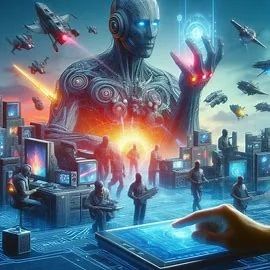Unit 70 Computer Game Engines
Most video game enthusiasts are aware of the crucial role that game engines play in creating immersive and dynamic gaming experiences. Unit 70 computer game engines are at the forefront of driving the technological advancements in the gaming industry.
These engines are distinguished by their cutting-edge graphics rendering capabilities and highly optimized performance that sets them apart from other game engines on the market. In this blog post, we will research into what makes Unit 70 computer game engines stand out and the key features that contribute to their success.

Core Components of Game Engines
While game engines are complex systems with many interconnected parts, they can typically be broken down into a few core components that are crucial for their functioning. These components work together seamlessly to bring digital worlds to life and provide an immersive experience for players.
Graphics Rendering Engine
The graphics rendering engine is responsible for creating all the visuals that players see in a game. This component handles tasks such as rendering 3D models, textures, lighting effects, and special effects. It works closely with the game’s art assets and shaders to ensure that everything looks as realistic and aesthetically pleasing as possible.
The graphics rendering engine plays a crucial role in optimizing performance and maintaining a high frame rate, which is vital for a smooth gameplay experience. It is constantly evolving to support new technologies and hardware, pushing the boundaries of what is visually possible in games.
Physics Engine
To create a realistic and dynamic game world, a physics engine is vital. This component simulates the laws of physics within the game environment, allowing objects to interact with each other in a realistic manner. It handles tasks such as collision detection, gravity, and object movement, ensuring that the game world behaves authentically.
Sound Engine
Sound is a crucial element in creating an immersive gaming experience. The sound engine is responsible for handling all audio aspects of the game, including music, sound effects, and voiceovers. It works in conjunction with the game’s events and triggers to provide audio feedback that enhances the player’s engagement.
Graphics The sound engine utilizes techniques such as spatial audio and real-time mixing to create a rich and dynamic audio landscape that complements the game’s visuals.
Scripting and AI
Scripting and AI play a vital role in shaping the behavior of non-player characters (NPCs) and creating interactive elements within the game world. The scripting engine allows game developers to write scripts that control the logic and behavior of NPCs, while the AI engine provides them with the ability to react intelligently to player actions.
Scripting By incorporating both scripting and AI components, game engines can create dynamic and engaging gameplay experiences that adapt to the player’s choices and actions.
Shadows Overall, these core components work together seamlessly to bring digital worlds to life and provide players with a captivating and immersive gaming experience.
User Interface Design and Development Tools
Many components come together to create a seamless and engaging user experience in a computer game. Among these, user interface design and development tools play a crucial role in shaping how players interact with the game. These tools not only determine the visual appeal of the game interface but also impact the overall user experience and navigation within the game environment.

Visual Editors and Level Design
Designing visually appealing game levels and interfaces is necessary for capturing the player’s attention and enhancing the overall gaming experience. Visual editors provide game developers with intuitive tools to create and design intricate game environments without the need for extensive programming knowledge.
These tools allow for the placement of assets, textures, lighting effects, and other elements to bring the game world to life. Level design tools help in structuring the gameplay, setting objectives, and creating challenges that engage players throughout the gaming experience.
Designers can use these visual editors to iterate on level designs, make adjustments in real-time, and test gameplay mechanics seamlessly. By providing a visual representation of the game environment, designers can fine-tune details, adjust the flow of the game, and ensure that the level design aligns with the overall game narrative and aesthetics.
This iterative process enhances the quality of the game and ultimately results in a more immersive and enjoyable gaming experience for players.
Animation and GUI Systems
Interface elements such as animated characters, graphical user interfaces (GUI), and interactive menus contribute significantly to the overall feel of the game. Animation systems provide developers with tools to create lifelike movements for characters, creatures, and objects within the game world.
GUI systems enable the design and implementation of user interfaces that display vital information such as health bars, inventory, maps, and interactive buttons seamlessly integrated into the gameplay.
Developers can customize animation and GUI systems to match the game’s art style, theme, and narrative, ensuring a cohesive visual experience for players. By incorporating dynamic animations and intuitive user interfaces, developers can enhance player engagement, improve immersion in the game world, and provide a seamless navigation experience.
These systems play a vital role in shaping the player’s interaction with the game and are necessary tools for creating captivating and interactive gaming experiences.
Asset Management and Integration
Editors provide game developers with the capability to manage and integrate a vast array of assets, including 3D models, textures, audio files, animations, and scripts. These tools streamline the process of importing, organizing, and manipulating assets within the game engine, ensuring efficient development workflows and smooth integration of components.
Asset management tools help developers maintain version control, track changes, and collaborate effectively on large-scale game projects.
Development teams can leverage asset management systems to optimize resource usage, reduce file clutter, and improve project organization. By integrating assets seamlessly into the game engine, developers can expedite the development process, maintain consistency in the game’s visual style, and ensure that all components work together harmoniously.
Efficient asset management and integration are necessary for delivering high-quality games within set timelines and budget constraints.
With strong asset management, visual editors, animation and GUI systems, game developers can create immersive and visually stunning gaming experiences that captivate players.
While these tools offer numerous benefits in streamlining development processes and enhancing user experiences, it is crucial for developers to continually update their skills and stay informed about the latest trends and advancements in user interface design and development.
By leveraging the power of these tools effectively, developers can push the boundaries of creativity and deliver groundbreaking gaming experiences that resonate with players worldwide.
Cross-Platform Development and Compatibility

Despite the growing complexities of modern computer game engines, the ability to develop games across multiple platforms has become a key focus for many developers. This not only allows for a wider reach and audience but also presents new challenges in terms of compatibility and performance across different devices.
Portability and Platform Challenges
Compatibility across various platforms like PC, console, and mobile devices can be a daunting task for developers. Each platform has its own unique specifications, hardware capabilities, and operating systems, which can lead to potential roadblocks in porting a game seamlessly.
Addressing these challenges requires a deep understanding of each platform’s requirements and limitations in order to optimize the game’s performance and ensure a consistent experience across all devices.
Ensuring portability is another crucial aspect of cross-platform development. Developers must consider factors such as screen sizes, input methods, and performance capabilities when designing a game that can be enjoyed on different devices.
Balancing the game’s visuals and mechanics to suit various platforms without compromising the overall gaming experience is a delicate yet important task in modern game development.
Tools for Cross-Platform Support
Cross Platform development tools have emerged to assist developers in creating games that can run seamlessly across multiple platforms. These tools provide important features and functionalities that streamline the development process and help address compatibility issues effectively.
For instance, tools like Unity and Unreal Engine offer robust cross-platform support that allows developers to build, test, and deploy games to a wide range of devices with ease. By utilizing these tools, developers can focus more on creating engaging gameplay experiences and less on the technical intricacies of porting their games to different platforms.
Optimization and Performance Capabilities
All modern computer game engines aim to deliver high-performance experiences to players. Unit 70 computer game engines are no exception, as they come equipped with advanced optimization techniques and performance capabilities that set them apart from other solutions on the market.

Profiling Tools and Performance Tuning
The ability to identify performance bottlenecks and optimize the code accordingly is crucial for achieving smooth gameplay experiences. Unit 70 computer game engines offer a range of powerful profiling tools that allow developers to analyze the performance of their games in real-time.
By using these tools, developers can pinpoint areas of code that are causing slowdowns and make targeted optimizations to improve overall performance.
Profiling tools also help developers streamline their game’s performance by identifying redundant or inefficient code. By fine-tuning the performance of critical systems, such as rendering or physics, developers can ensure that their games run smoothly on a wide range of hardware configurations.
Scalability and Resource Management
Profiling the scalability of a game engine is crucial for ensuring that it can adapt to the resources available on different platforms. Unit 70 computer game engines excel in scalability and resource management, allowing developers to optimize their games for various hardware configurations without sacrificing performance.
In addition to optimizing performance for different hardware setups, Unit 70 computer game engines also offer robust resource management capabilities. This includes efficient memory allocation strategies and asset loading techniques that help minimize loading times and maximize the utilization of available resources.
Optimization: When working with Unit 70 computer game engines, developers can leverage the advanced optimization and performance capabilities to create high-quality games that deliver smooth experiences across a wide range of devices, making them stand out in the competitive gaming industry.
Networking and Multiplayer Functionality
To achieve seamless multiplayer experiences, game engines need to implement robust network architecture and protocols. Any game engine worth its salt will support various network architectures such as peer-to-peer and client-server models. These architectures dictate how game instances communicate with each other, ensuring smooth interactions between players.
Furthermore, support for common networking protocols like TCP/IP and UDP is crucial for efficient data transmission and synchronization.
Additionally, any reliable game engine should offer features like latency compensation and network prediction to handle network delays and ensure a consistent experience for all players. These mechanisms are crucial for maintaining smooth gameplay even in the face of network fluctuations.
Synchronizing Game States
To ensure that all players have a consistent view of the game world, game engines must synchronize game states effectively. One common approach is to use techniques such as lockstep simulation or state synchronization. These methods sync up player actions and game events across all instances, preventing discrepancies between players.
Game engines often employ techniques like delta encoding or interpolation to reduce bandwidth usage and improve synchronization accuracy. By only transmitting changes in game state, engine can minimize network traffic while maintaining a coherent gaming experience for all players.
Unique Features That Differentiate Game Engines
A necessary aspect that sets game engines apart is their proprietary technologies. These are tools and features unique to each engine that can significantly impact game development. For example, some game engines offer advanced AI systems that can streamline the creation of complex in-game behaviors. Others may provide specialized rendering capabilities that enhance the visual quality of the game.
Proprietary technologies can give developers a competitive edge by enabling them to create distinctive gameplay experiences that stand out in the crowded gaming market. By leveraging these tools effectively, game developers can push the boundaries of creativity and innovation in game design.
Community and Modding Support
That community and modding support is another key feature that differentiates game engines. The ability to engage with a vibrant community of developers and modders can greatly enhance the overall game development process. Community forums, wikis, and online tutorials provide invaluable resources for developers seeking guidance and solutions to technical challenges.
Plus, game engines that actively support modding enable players to personalize and extend their gaming experience. This fosters a sense of ownership and creativity among the player base, leading to a more dedicated and engaged community around the game.
Licensing and Cost Considerations
Game licensing and cost considerations play a crucial role in selecting the right game engine for a development project. Some engines offer free or low-cost options for indie developers or small studios, making game development more accessible and cost-effective. On the other hand, licensing fees for commercial use can vary significantly depending on the engine’s features and target market.
Considerations such as ongoing support, regular updates, and revenue-sharing models should also be taken into account when evaluating the overall cost of using a particular game engine. Careful analysis of licensing agreements is necessary to ensure that the engine aligns with the project’s budget and long-term goals.
Choosing the Right Game Engine
Not all game engines are created equal, and choosing the right one for your project can make a significant impact on its success. Understanding how to select the appropriate game engine for your game development needs is crucial.
Analyzing Project Requirements
Choosing the right game engine starts with analyzing your project requirements. Consider the type of game you are developing, the platform you are targeting, the size of your team, and your level of expertise. Different game engines offer various features and support different platforms, so matching your project requirements with the capabilities of the game engine is crucial.
Additionally, consider factors such as graphics quality, networking capabilities, ease of use, and community support. Make a list of must-have features for your project and use it as a guideline when evaluating different game engines.
Comparing Popular Game Engines
Choosing the right game engine can be a daunting task, especially with so many options available in the market. To help you make an informed decision, let’s compare some of the most popular game engines used by developers today.
| Game Engine | Key Features |
| Unity | Strong cross-platform support, extensive asset store, robust community |
| Unreal Engine | High-quality graphics, visual scripting system, VR support |
| CryEngine | Advanced rendering capabilities, realistic lighting system, scalable platforms |
When comparing popular game engines, consider factors such as licensing costs, programming languages supported, scalability, and overall performance. Each game engine has its strengths and weaknesses, so choose one that aligns with your project requirements and development preferences.
Comparing Popular Game Engines
Choosing the right game engine can be a daunting task, especially with so many options available in the market. To help you make an informed decision, let’s compare some of the most popular game engines used by developers today.
| Game Engine | Key Features |
| Unity | Strong cross-platform support, extensive asset store, robust community |
| Unreal Engine | High-quality graphics, visual scripting system, VR support |
| CryEngine | Advanced rendering capabilities, realistic lighting system, scalable platforms |
Future Trends and Developments in Game Engine Technology
Once again, the world of game engine technology is at the forefront of innovation and development. As we look towards the future, it is vital to consider the emerging trends and advancements that will shape the landscape of interactive entertainment.
Emerging Technologies and Their Impact
Technology continues to evolve rapidly, with advancements in areas such as artificial intelligence, ray tracing, and virtual reality pushing the boundaries of what is possible in game development.
These innovations are not only enhancing the visual fidelity and realism of games but also revolutionizing gameplay mechanics and player experiences. Game engines are incorporating these technologies to empower developers to create more immersive and engaging worlds.
Artificial intelligence is playing a significant role in shaping the future of game development, enabling smarter NPCs, more dynamic environments, and personalized player experiences. As AI algorithms continue to improve, game engines will leverage this technology to deliver more realistic and responsive virtual worlds, blurring the line between the real and digital realms.
The Role of Game Engines in New Forms of Media
Media consumption is evolving beyond traditional boundaries, with interactive experiences becoming increasingly prevalent in areas such as virtual reality, augmented reality, and mixed reality. Game engines are at the forefront of this transformation, providing the tools and technology to create immersive content for a diverse range of platforms and devices.
Any form of media that involves user interaction or real-time rendering can benefit from the capabilities of modern game engines. From virtual tours and educational simulations to interactive storytelling and live events, game engines are enabling creators to push the boundaries of what is possible in digital entertainment. As the demand for interactive experiences continues to grow, game engines will play a pivotal role in shaping the future of media consumption.
Conclusion
Upon reflecting on Unit 70 Computer Game Engines, it is clear that what sets them apart is their ability to provide the necessary tools and resources for game developers to create high-quality and visually stunning games.
These engines offer a range of features such as graphic rendering, physics simulations, and artificial intelligence capabilities that allow developers to bring their imaginative worlds to life.
Furthermore, the flexibility and customization options of game engines enable developers to tailor their creations to specific platforms and target audiences.
As technology continues to advance, we can only expect game engines to evolve and become even more sophisticated, further pushing the boundaries of what is possible in the world of game development.

